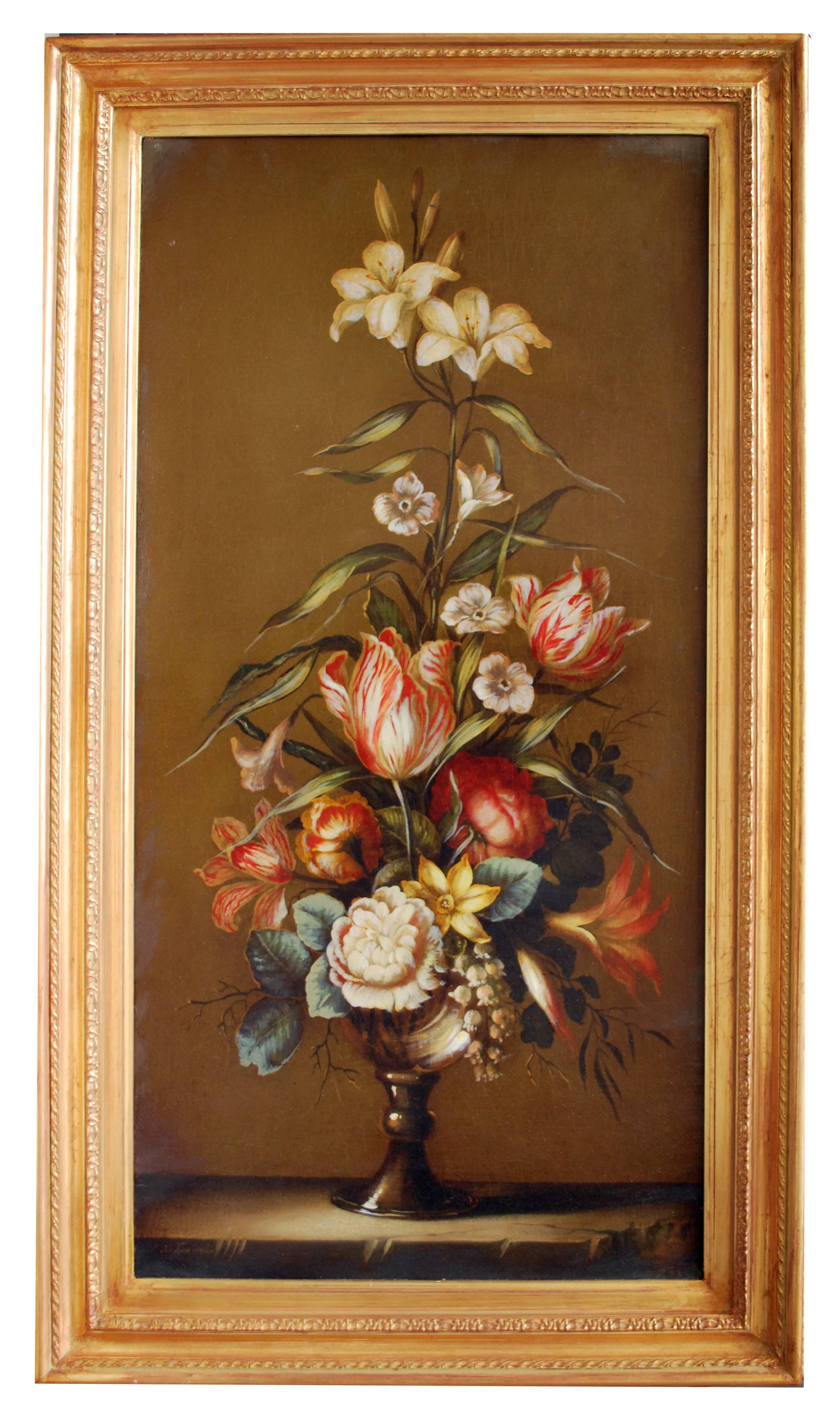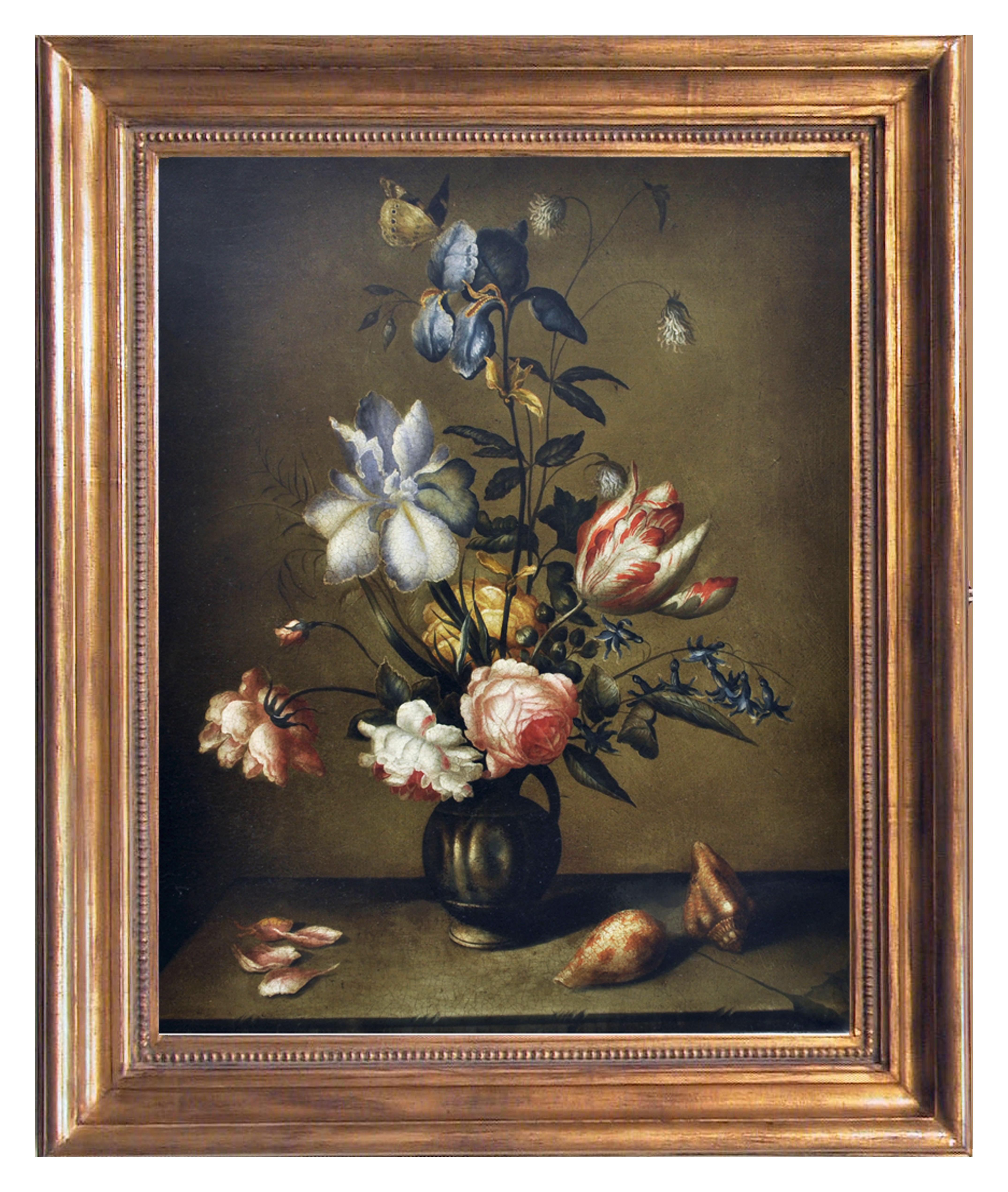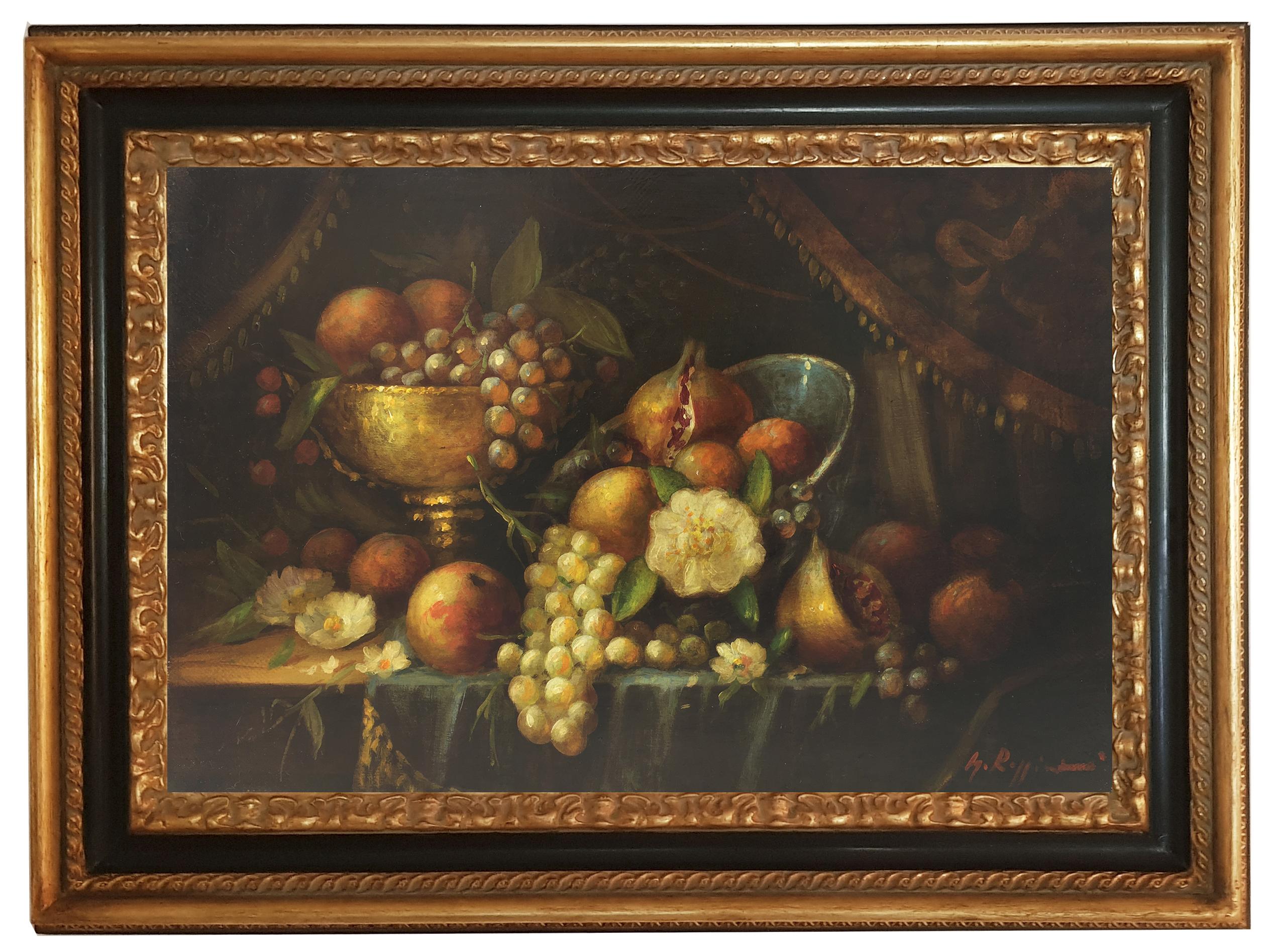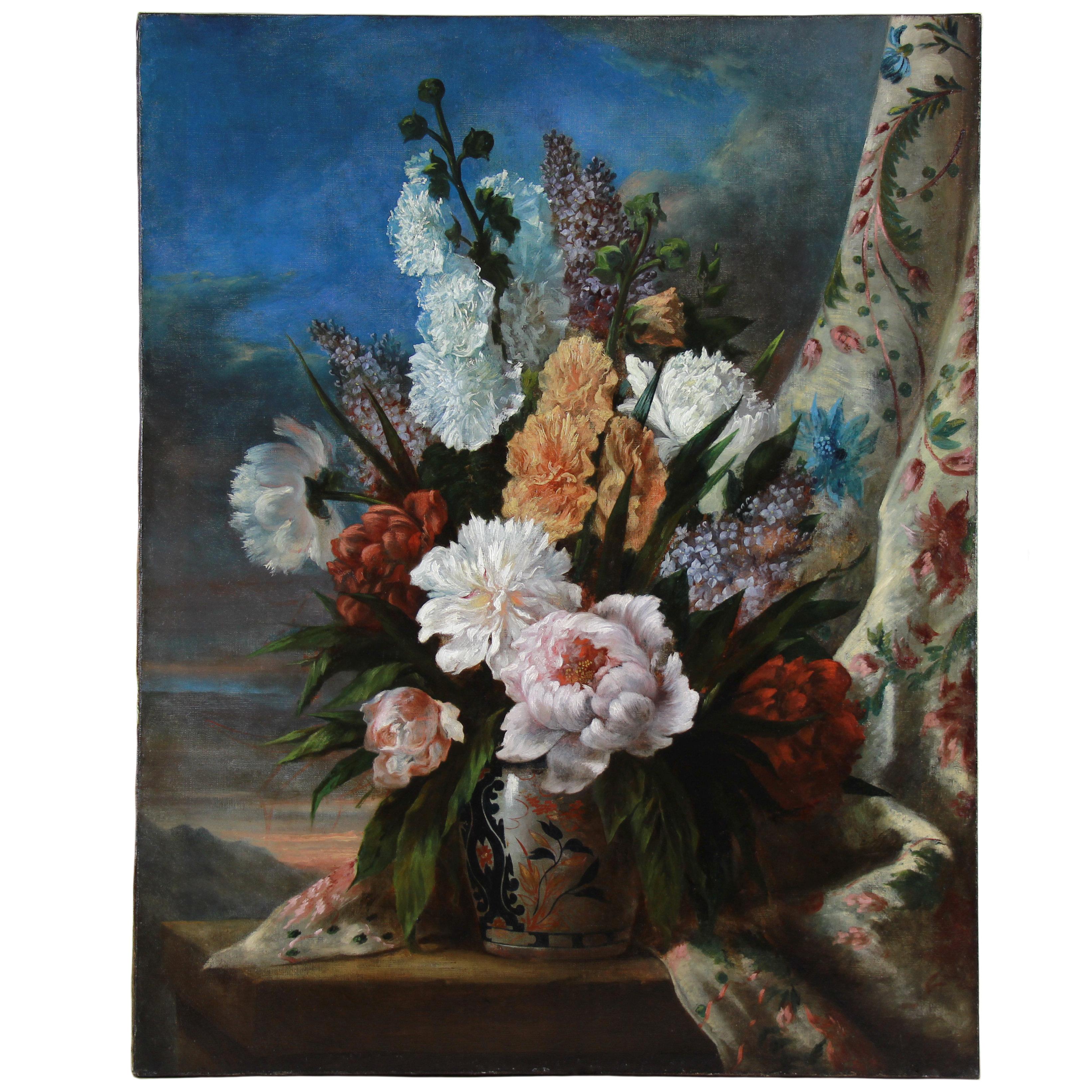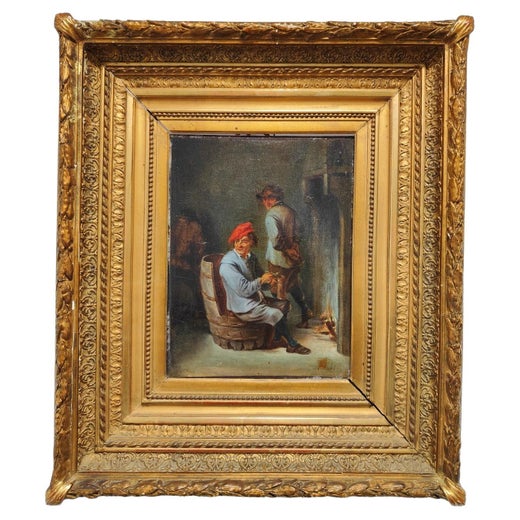Items Similar to A tavern interior with a dog and kitchen utensils
Want more images or videos?
Request additional images or videos from the seller
1 of 8
David Teniers the YoungerA tavern interior with a dog and kitchen utensils
About the Item
A tavern interior with a dog and kitchen utensils in the foreground. Signed lower left: TENIERS F. Oil on panel. 28 x 36,2 cm. Attribution RKD, the Hague
Provenance
Private collection, Belgium. Sotheby's, London, 13.5.2003, Lot 9. Kunsthandel P. de Boer, Amsterdam.
European private collection.
David Teniers was one of the most famous 17th-century artist dipicting peasant life. He enjoyed international
popularity in his own lifetime and especially during the 18th century. Teniers's success was marked by the
acquisition of a country house in 1662 and by the grant in 1680 of a patent of nobility. His work was imitated by
many followers, including his son, David Teniers III.
Teniers was born in Antwerp and probably trained by his father, David Teniers the Elder. An important
influence for the young artist were works by Adrian Brower and than by the art if Rubens, who was a a witness
at Teniers' wedding. From the beggining Teniers produced a more refined version of Brouwer's peasant
scenes, and later created scenes of fashionable life. With time he also abandoned dark frank colour in favour of
a magic which is able to give his warm neutrals a suggestion of every sort of colour. The characteristic which
was influenced by his father-in-law Jan Breughel.
Teniers became a master in the guild of Saint Luke in Antwerp in 1632 or 1633. By 1649 he was probably
already working for the King of Spain, as well as for Prince William of Orange and the Governor of the
Netherlands, the Archduke Leopold William.
In 1651 Teniers moved to Brussels where Archduke Leopold
became his main employer. The archduke had assembled a famous collection of paintings, which became the
nucleus of the Kunsthistorisches Museum in Vienna.
This still life is not a characteristic and a rare work by the master. His work mostly consists of genre painting.
the 1640s. The subject, with its variety of still life and picturesque possibilities of illumination, waas very popular in Hollande of 17th century. Teniers gave it its
most sumptuous. The present painting is one of these genre paintings. It is not clear is it a still life or a genre painting, it is more kind of a view from the back kitchen to a tavern where two mer keep talking. But the foregournd is occupied by the utensils and a sleeping dog. All this sounds like illustrative features carelessly heaped up. All the objects, colours and textures have their compositional value, the light gives delicacy to every piece, no matter how old or old it can seem. Nothing could be shifted, taken away or added without some impairment of pictorial unity. Perhaps the picture should be regarded chiefly as a stunt-if so, a stunt magnificently carried off.
- Creator:David Teniers the Younger (1610 - 1690, Flemish)
- Dimensions:Height: 11.03 in (28 cm)Width: 14.26 in (36.2 cm)
- Medium:
- Movement & Style:
- Period:
- Condition:
- Gallery Location:Tallinn, EE
- Reference Number:1stDibs: LU2243213193982
David Teniers the Younger
David Teniers the Younger was a 17th-century Flemish painter known for his luminous depictions of peasant life. His work was greatly influenced by the tavern scenes of Adriaen Brouwer and the fluid paint handling of Peter Paul Rubens. Born on December 15, 1610 in Antwerp, Belgium, he was the son of the artist David Teniers the Elder, with whom he studied as a youth. Notably, Teniers later married the daughter of the painter Jan Brueghel the Elder. In the early 1630s, the Haarlem-based painter Brouwer moved to Antwerp, Teniers exposure to his low-genre paintings was a turning point in his career. Over the following decades, he enjoyed a popular reputation around Europe. Though most of his works were modest in scale, he was a prolific artist and is thought to have completed some 2,000 paintings over the course of his career. Teniers died on April 25, 1690 in Brussels, Belgium. Today, his work can be found in the Louvre in Paris, the National Gallery of Art in London, the Hermitage Museum in St. Petersburg, and the Rijksmuseum in Amsterdam, among others.
About the Seller
No Reviews Yet
Vetted Seller
These experienced sellers undergo a comprehensive evaluation by our team of in-house experts.
Established in 2018
1stDibs seller since 2022
Typical response time: 1 to 2 days
- ShippingRetrieving quote...Ships From: Tallinn, Estonia
- Return PolicyA return for this item may be initiated within 2 days of delivery.
More From This SellerView All
- A tavern interior with a dog and kitchen utensils in the foregroundBy David Teniers the YoungerLocated in Tallinn, EEDavid Teniers, the Younger (1610, Antwerp – 1690, Brussels) A tavern interior with a dog and kitchen utensils in the foreground. Signed lower left: TENIERS F. Oil on panel. 28 x 36,2...Category
17th Century Dutch School Still-life Paintings
MaterialsCanvas, Oil
- A winter landscape with huntersLocated in Tallinn, EEHendrikus van de Sande Bakhuyzen (The Hague 1795-1860) A winter landscape with hunters on a path along a stream Signed and dated 'H vd S. Bak...Category
1820s Dutch School Figurative Paintings
MaterialsCanvas, Oil
- Interior with gathering of musiciansLocated in Tallinn, EE(1601, Delft – 1673, Amsterdam) Interior with gathering of musicians. Circa 1635. Oil on panel. 59.3 x 82 cm. Provenance Jules Porgès Collection, Paris , 1911. Fine Art Gallery...Category
1630s Dutch School Interior Paintings
MaterialsOil, Panel
- Summer Landscape in the Meuse ValleyBy Andreas SchelfhoutLocated in Tallinn, EEAndreas Schelfhout (1787 The Hague - 1870 The Hague]0 Summer Landscape in the Meuse Valley Oil on panel. 69 x 92.5 cm. Signed lower right: A. Schelfhout f. Provenance Gemäldegalerie...Category
1850s Realist Landscape Paintings
MaterialsCanvas, Oil
- OuranophobiaBy Ged QuinnLocated in Tallinn, EEGed Quinn b. 1963 Ouranophobia Executed in 2012. Signed Ged Quinn twice and dated 2012 twice (on the stretcher) Oil on canvas. 244 by 200cm. Ged Quinn was born in 1963 in Liverpool,...Category
2010s Figurative Paintings
MaterialsCanvas, Oil
- Nude modelLocated in Tallinn, EESigned 1934. Oil on canvas. 92 x 142 cm. The artist was born in the family of a locksmith, engaged in the manufacture of relief seals. In 1887 he was enrolled as a student at the Central School of Technical Drawing of Baron A. Stieglitz. L. Stieglitz. He studied lithography and etching with V.V. Mathe. During his studies he received a number of awards, annually participated in pupil exhibitions, and published his works in the "Pictorial Review" and "World Literature" magazines. In 1892 he left the course of his studies. He went to Siberia, where he worked as an engraver in the publishing house of P.I. Makushin. From 1895 he was an engraver of the Expedition of Preparation of State Securities in St. Petersburg. In 1902 and 1906, he went abroad to improve his skills using the funds of the Imperial Academy of Arts. In 1905 on the petition of Mathe was awarded the title of academician. He worked mainly in the technique of color etching. He created a number of engraved portraits of people of Russian culture (Alexander Pushkin from the original by O.A. Kiprensky and V. A. Tropinin, 1890s; A.G. Rubinstein from the original by I. Repin. Repin, 1895; Leo Tolstoy, 1890s; Konstantin Soldatenkov, 1902; Henryk Siemiradzki, 1904; Ivan Turgenev, 1905; Mikhail A. Zichi, 1910), representatives of the nobility and members of the imperial family. He made engraved copies of paintings of the Hermitage, the Russian Museum of Emperor Alexander III, and ex-libris. Exhibited his works at Spring exhibitions in the halls of the Imperial Academy of Arts, and exhibitions of the Association of Artists. Member of the society "Mussar Mondays. In 1904 he became one of the founders of the Russian Art and Industry Society. In 1917 he painted a portrait of A.F. Kerensky, and in 1918 - a portrait of V.I. Lenin. Participated in the festive decoration of the streets of Petrograd for the first anniversary of October (the embankment of the Ekaterina Canal). Exhibited his works at the First State Free Art Exhibition in Petrograd (1919), the First Russian Art Exhibition in the Van Diemen's Gallery in Berlin (1922), and the "Russian Book...Category
1930s Nude Paintings
MaterialsCanvas, Oil
You May Also Like
- FLOWERS - Carlo De Tommasi - Still Life Oil on canvas Italian PaintingBy Carlo De TommasiLocated in Napoli, ITFlowers - Carlo De Tommasi - Italia 2007 This is his reinterpretation of a greatest old master painting by Jan Van Os. Oil on canvas cm. 80x40.Category
Early 2000s Dutch School Still-life Paintings
MaterialsCanvas, Oil
- STILL LIFE - Massimo Reggianil - Oil on Canvas Italian PaintingBy Massimo ReggianiLocated in Napoli, ITSTILL LIFE - Oil on canvas painting by Massimo Reggiani, Italy 2006 The origins of still life can be found in Dutch painting. At the beginning of Dutch painting, artists included add...Category
Early 2000s Dutch School Still-life Paintings
MaterialsOil, Canvas
- STILL LIFE - In the Manner of J. van Walscapelle -Italian Oil on Canvas PaintingBy Gianluca D'EsteLocated in Napoli, ITStill life - Oil on canvas cm.42x30, Italy 1998, Gianluca d'Este Here we admire a composition of white and red grapes, apples, a beautiful chalice on a table with a satin drapery. Th...Category
1990s Dutch School Still-life Paintings
MaterialsCanvas, Oil
- FLOWERS - Dutch SchooI -Italian Still Life Oil on Canvas PaintingBy Carlo De TommasiLocated in Napoli, ITFlowers - Carlo De Tommasi Italia 2010 - Oil on canvas cm. 70x55 In this precious oil painting, Carlo De Tommasi is inspired by the compositions of the Dutch Balthasar van der Ast, ...Category
Early 2000s Dutch School Still-life Paintings
MaterialsCanvas, Oil
- STILL LIFE - Massimo Reggiani - Oil on canvas Italian PaintingBy Massimo ReggianiLocated in Napoli, ITStill life - Massimo Reggiani Italia 2007 - Oil on canvas cm. 40x60 The origins of still life are found in Dutch painting, among other sources. At the beginning of Dutch painting, ar...Category
Early 2000s Dutch School Still-life Paintings
MaterialsOil, Canvas
- Oil On Canvas "Still life with flowers and vase" Atr. to Cornelis van SpaendonckLocated in Gavere, BEOil On Canvas "Still life with flowers and vase" Atr. to Cornelis van Spaendonck Biography: Cornelis van Spaendonck ( 7 December 1756 – 22 De...Category
1830s Dutch School Still-life Paintings
MaterialsGold Leaf
Recently Viewed
View AllMore Ways To Browse
The Antique Kitchen
Kitchen In Interiors
Antique Kitchen Art
Used Kitchens London
Antique Kitchen Signs
Old Antique Kitchens
Used Utensils
Antique Dog Sign
The Antique Guild
King Of The Belgians
The Tavern
Utensil Art
Antique Utensils
Dutch Master Of Young
Antique Tavern
Orange Dog
Antique Dog House
Antique Wedding Frames
